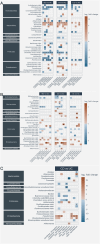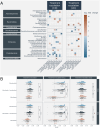Microbial Patterns in Newly Diagnosed Inflammatory Bowel Disease Revealed by Presence and Transcriptional Activity - Relationship to Diagnosis and Outcome
- PMID: 40491932
- PMCID: PMC12148070
- DOI: 10.2147/CEG.S504459
Microbial Patterns in Newly Diagnosed Inflammatory Bowel Disease Revealed by Presence and Transcriptional Activity - Relationship to Diagnosis and Outcome
Abstract
Background: As part of the IBD Character initiative, we examined an inception cohort and investigated mucosal microbiota composition and transcriptional activity in relation to clinical outcomes.
Methods: A cohort of 237 individuals were included from five countries: Crohn's disease (CD, n = 72), ulcerative colitis (UC, n = 57), symptomatic non-IBD controls (SC, n = 78) and healthy controls (HC, n = 30). Rectal/colonic biopsies were obtained at inclusion, and DNA and RNA were extracted from the same biopsy and examined by sequencing the 16S rRNA V4 region.
Results: Beta diversity measurements separated IBD from both HC and SC. IBD and SC exhibited reduced intra-individual diversity compared with HC. When comparing taxonomy at DNA and RNA level, six bacteria were found to differ in abundance and/or transcriptional activity between IBD and symptomatic control, while there were 14 and three between symptomatic control and CD and UC, respectively. A limited number of bacterial taxa were responsible for the largest difference between presence and activity, separating patients and controls. Multiple bacterial taxa were associated with treatment escalation in both UC and CD. Machine-learning models separated IBD from symptomatic controls and treatment escalators from non-escalators (AUC >0.8). However, the differential effects were mainly driven by clinical biomarkers, such as f-calprotectin, s-albumin, and b-hemoglobin.
Conclusion: Differences between presence and transcriptional activity were found among multiple taxa when assessing 16S rRNA at DNA and RNA level. Symptomatic controls were more similar to the IBD patients compared to HC. The analyses suggest that the mucosal microbiota carries a moderate diagnostic and predictive potential, outcompeted by f-calprotectin.
Keywords: DNA; IBD; RNA; biomarkers; microbiota.
© 2025 Vatn et al.
Conflict of interest statement
Dr Daniel Bergemalm reports personal fees from BMS, personal fees from pharmacosmos, personal fees from Janssen, personal fees from Takeda, personal fees from Sandoz, personal fees from Pfizer, personal fees from Sandoz, outside the submitted work. Dr Trond Espen Detlie reports personal fees from AbbVie, personal fees from Ferring, personal fees from Pfizer, personal fees from Pharmacosmos, personal fees from Takeda, personal fees from Tillotts, personal fees from CLS Vifor Pharma, outside the submitted work. Dr Rahul Kalla reports grants from MRC, grants from Crohn’s and Colitis UK, outside the submitted work. Dr Jonas Halfvarson reports personal fees from AbbVie, personal fees from BMS, personal fees from Eli Lilly, personal fees from Alfasigma, personal fees from Aqilion, personal fees from Celltrion, personal fees from Ferring, personal fees from Galapagos, personal fees from Gilead, personal fees from Index Pharma, grants, personal fees from Janssen, personal fees from Medtronic, personal fees from Merck, grants, personal fees from MSD, personal fees from Novartis, personal fees from Pfizer, personal fees from Prometheus Laboratories Inc., personal fees from Sandoz, personal fees from Shire, personal fees from STADA, grants, personal fees from Takeda, personal fees from Thermo Fisher Scientific, personal fees from Tillotts Pharma, outside the submitted work. Prof Dr Johannes Hov reports grants from South-Eastern Norway Regional Health Authority, during the conduct of the study. Dr Petr Ricanek reports grants from EU FP7 grant: IBD-CHARACTER (contract # 2858546), grants from South-Eastern Norway Regional Health Authority (project numbers 2014011, 2018001 and 2020066), during the conduct of the study. The authors declare no conflicts of interest related to this work.
Figures





References
LinkOut - more resources
Full Text Sources
Research Materials

